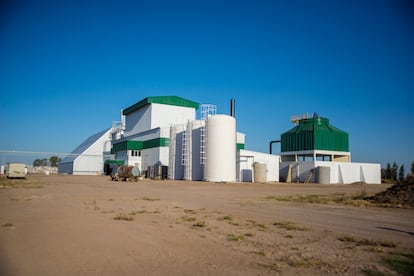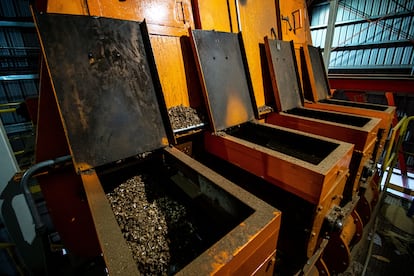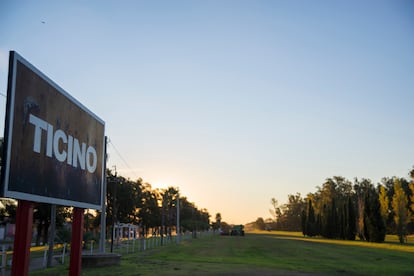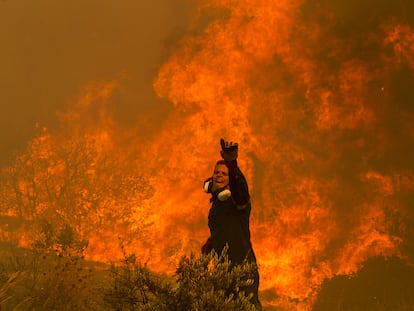Ticino, the Argentinean town lit by peanut shells, where the power never goes out
Using this biomass resource, a power plant supplies 3,000 inhabitants with clean energy and resolves a long-standing environmental and social problem

On Sunday, June 16, 2019, an unprecedented blackout left the whole of Argentina without power. An operational error (which is still under investigation) led to a massive failure, disconnecting the entire Argentine Interconnection System for over 13 hours; the outage also affected several cities in Uruguay and Paraguay. In total, over 50 million people were left completely in the dark. Meanwhile, in Ticino, a small town located in the province of Córdoba, the 3,000 inhabitants went on with their lives as usual — thanks to the generation of electricity from peanut shells, energy service was unaffected. Today, the use of this biomass resource supplies the town with clean energy and has made it possible to solve a years-long environmental and social problem.
The story begins over 15 years ago in the province of Córdoba, where the “peanut belt” is made up of several cities and towns, including Ticino. After China and the United States, Argentina is the third-largest peanut producer in the world. Because of the climatic conditions, the product exported from this country is in great demand in European and Latin American markets. High production, sales growth and export records created an environmental problem: what to do with all the peanut shells that were discarded, left scattered in the fields, and started fires (because of the humid conditions) that affected people’s daily lives.
The plan, which until then was a private initiative of the Lorenzatti Ruech peanut company, started to gain steam with an initial investment of $8 million and consisted of creating the Ticino Biomass Power Company and a large power plant. In 2018, private capital was supplemented with state assistance through the “RenovAR” program, which assists industries around the country with projects for generating electricity from renewable sources. The agreement establishes that the government itself buys the energy at a stable price; once it enters the general power grid, it is available to supply people with electricity.
Two problems, one solution
In addition to the environmental problem of burning peanut shells and the attendant smoke that caused considerable discomfort in the town, there was another major issue: Ticino had never had a good electric power network. “The town has a deteriorated network; the problem is that we always had a lot of power outages, some of which were micro-outages that lasted a few seconds or minutes, even a thousandth of a second. But that is enough to paralyze an industry’s production for two hours,” Pablo Margiaria, Ticino’s Secretary of Management and Communication, tells EL PAÍS.

In the context of increased production, industry expansion and the arrival of new players in the peanut industry, it was essential to solve the energy problem. Margiaria explains that around 80% of Argentinean peanuts are produced in the “peanut belt.” In total, an estimated 45,000 tons of peanut shells are discarded each year. Now, they are used to generate electricity.
How energy is made from peanut shells
“The amount of peanut shells we were going to have was an essential part of the project,” says 44-year-old Diego Menta, an electrician and the director of the Ticino Biomass Power Plant. He has been working in the peanut industry for 23 years and when he heard about the renewable energy project, he immediately wanted to be involved in it. “The plant is linked to the company that processes peanuts, which supplies us with an average of 80% or 85% of the shells needed for the process. The rest have to be purchased,” he says.
The process is complex from the outset. First, the shells arrive at the power plant via two methods: by truck and by pneumatic transport (they are blown from one building to another). Then, says Menta, they are unloaded into cells and storage sheds to maintain quality and humidity. Later, the shells are transferred to the boiler, where they are burned in stages until only ashes remain.
“With that heat, water is heated and it creates saturated steam. It goes back through the boiler again and is transformed into very high-temperature steam that looks like compressed air and is transported to the turbine, which spins at 6,500 revolutions per minute and then reduces its speed to 1,500,″ he explains. “All that speed is converted into force and connects to the generator. That’s the simple process: going from thermal energy to mechanical energy. Once it has delivered all its energy, that steam is absorbed, cools down, turns into water and returns to the boiler to start the cycle again.”

The cycle is repeated constantly, 24 hours a day, 365 days a year. Thus, Menta has a team of 32 people, including boiler operators and biomass movement operators. The energy is incorporated into the system through the Compañía Administradora del Mercado Mayorista Eléctrico Sociedad Anónima (Cammesa; Wholesale Electricity Market Administration Limited Public Corporation), to which the plant sells the energy at a stable price.
The town where the power never goes out
Although Ticino is part of the National Interconnected Energy System, when a power failure or cut affects the area’s energy suppliers, a protocol is activated, and the whole town is connected to the biomass power plant through a closed circuit.
What happened on June 16, 2019 — when the whole country went dark except Ticino — was no exception. Last March 1, about 20 million users in Argentina were left in the dark in the middle of a heatwave because of a fire in a high-voltage network near the Atucha II nuclear power plant, in the province of Buenos Aires. On that occasion, Ticino also maintained its power supply.
“There are a lot of power outages here during the day; we see the problem, but nobody in town hears about it because the plant withstands it,” explains Menta. However, he notes that sometimes it can take a few seconds or minutes until the service is restored. “The 2019 blackout was historic, but we did not appreciate the magnitude of what was happening that day. The town experienced a revolution… For us at the plant, it was just another maneuver, but this town was the only one that had energy; it had a very big social impact.”

Margiaria emphasizes that generating renewable electricity has solved two problems: the lack of quality energy and the environmental issues caused by the peanut shells. “This put Ticino on the map; we started to receive industrial tourism,” he says. Menta explains that it is not easy to promote this type of renewable energy system because of the costs, but he hopes that governments will support similar projects. “What seems like a small energy solution today could be bigger in the future,” he says.
Sign up for our weekly newsletter to get more English-language news coverage from EL PAÍS USA Edition
Tu suscripción se está usando en otro dispositivo
¿Quieres añadir otro usuario a tu suscripción?
Si continúas leyendo en este dispositivo, no se podrá leer en el otro.
FlechaTu suscripción se está usando en otro dispositivo y solo puedes acceder a EL PAÍS desde un dispositivo a la vez.
Si quieres compartir tu cuenta, cambia tu suscripción a la modalidad Premium, así podrás añadir otro usuario. Cada uno accederá con su propia cuenta de email, lo que os permitirá personalizar vuestra experiencia en EL PAÍS.
¿Tienes una suscripción de empresa? Accede aquí para contratar más cuentas.
En el caso de no saber quién está usando tu cuenta, te recomendamos cambiar tu contraseña aquí.
Si decides continuar compartiendo tu cuenta, este mensaje se mostrará en tu dispositivo y en el de la otra persona que está usando tu cuenta de forma indefinida, afectando a tu experiencia de lectura. Puedes consultar aquí los términos y condiciones de la suscripción digital.
More information
Archived In
Últimas noticias
Raúl Rocha, from jet-setting with Miss Universe to arms trafficking and fuel theft
80,000 barrels of Mexican oil sent to Cuba: Havana drawn into the US–Mexico clash
Human rights activists, opposition members, and a minor: Maduro’s other political prisoners
Israel sparks a civil war within the MAGA movement
Most viewed
- Reinhard Genzel, Nobel laureate in physics: ‘One-minute videos will never give you the truth’
- Pablo Escobar’s hippos: A serious environmental problem, 40 years on
- Charles Dubouloz, mountaineering star, retires at 36 with a farewell tour inspired by Walter Bonatti
- Why we lost the habit of sleeping in two segments and how that changed our sense of time
- The Florida Keys tourist paradise is besieged by immigration agents: ‘We’ve never seen anything like this’










































